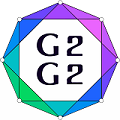Speaker
Description
Let $G$ be a group acting transitively on a finite set $\Omega$. Then $G$ acts on $\Omega\times \Omega$ componentwise. Define the orbitals to be the orbits of $G$ on $\Omega\times \Omega$. The diagonal orbital is the orbital of the form $\Delta=\{(\alpha,\alpha)\vert \alpha \in \Omega\}.$ The others are called non-diagonal orbitals. Let $\Gamma$ be a non-diagonal orbital. Define an orbital graph to be the non-directed graph with vertex set $\Omega$ and edge set $(\alpha,\beta)\in \Gamma$ with $\alpha,\beta\in \Omega$. If the action of $G$ on $\Omega$ is primitive, then all non-diagonal orbital graphs are connected. The orbital diameter of a primitive permutation group is the supremum of the diameters of its non-diagonal orbital graphs.
There has been a lot of interest in finding bounds on the orbital diameter of primitive permutation groups. In my talk I will outline some important background information and the progress made towards finding specific bounds on the orbital diameter. In particular, I will discuss some results on the orbital diameter of the groups of simple diagonal type and their connection to the covering number of finite simple groups. I will also discuss some results for affine groups, which provides a nice connection to the representation theory of quasisimple groups.

